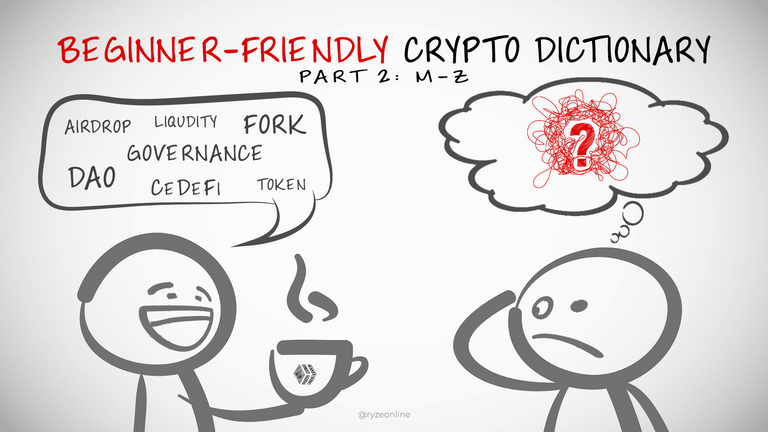
Part 1 Here - How Well Do You Speak Crypto? (Beginner Cryptionary A-L)
M
Market Cap ⭐⭐⭐
| Definition | Example |
|---|
| 'Market Capitalisation' is an indicator that measures the market value of a stock. For a cryptocurrency like Bitcoin, it's the total value of all coins mined to date. It’s calculated by multiplying the number of coins in circulation by the current market price of a single coin. (One way to think about market cap is as a rough gauge for how stable an asset is likely to be.) | “I guess it’s bad that when I invest in coins I really only look at each one’s MARKET CAP.” |
Help: I appreciate anyone kindly clarifying this definition for readers and myself.
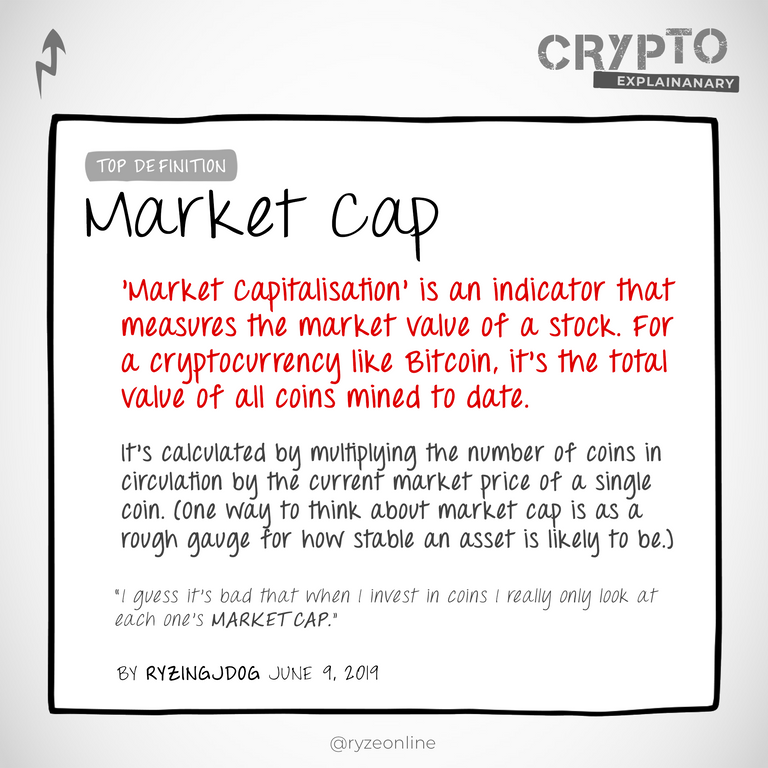
Maxi / Maximalist ⭐
| Definition | Example |
|---|
| A maximalist believes 'their way' is the best way, and that all other ways are inferior. For example, a bitcoin maximalist would insist that Bitcoin is the only/main digital asset that will be needed in the future. They'd suggest other digital currencies are inferior to Bitcoin. They'd argue strongly that other cryptocurrencies aren't aligned with the established ideals of crypto. They can be likened to 'zealots.' | “Bitcoin is the way, the future, and life. I may be a ‘narrow-minded’ Bitcoin MAXIMALIST but I won’t apologize for it.” |
MetaMask ⭐⭐
| Definition | Example |
|---|
| Blockchain technology is drastically changing the web. Crypto transactions and dApps (decentralized apps) are storing tons of data and offering lots of opportunities. But unlike the traditional web, browsers such as Chrome and Safari aren't able to surf all this data yet. So MetaMask was created. It acts as a 'bridge' that lets you visit the 'decentralized' web of tomorrow in today's web browser. It lets you run Ethereum dApps right in your browser without running a full Ethereum 'node.' It also acts as a crypto wallet at the same time. | “METAMASK is probably the most popular wallet, and although some say it's 'less secure', I just connect my MetaMask to my Trezor hardware wallet and I'm all set.” |
Miner Fee ⭐
| Definition | Example |
|---|
| Miner fees are a cost that spenders may include in any on-chain transaction. The fee may be collected by the miner who includes/records the spender's transaction in a block. | “I've made transactions on the blockchain for years and I only just realized the gas I'm paying is to reward the miners for all their verification services, they're actually MINER FEES!” |
Mining ⭐
| Definition | Example |
|---|
| Transactions are happening on the blockchain all the time. But just like with traditional money, scams and fraud can be a big problem. So, crypto transactions must be validated & secured to prevent fraud. 'Mining' is really just 'the process of securing transactions on a blockchain.' Without 'miners' doing the 'mining' for every transaction, any average hacker could hack and abuse the cryptocurrency. The most common form of mining is using powerful computers to create complex encryptions for every transaction made. (See Also: Hash.) | “Dad, can you buy me a new computer? I can earn a lot of bitcoin if I start MINING to help the blockchain out.” |
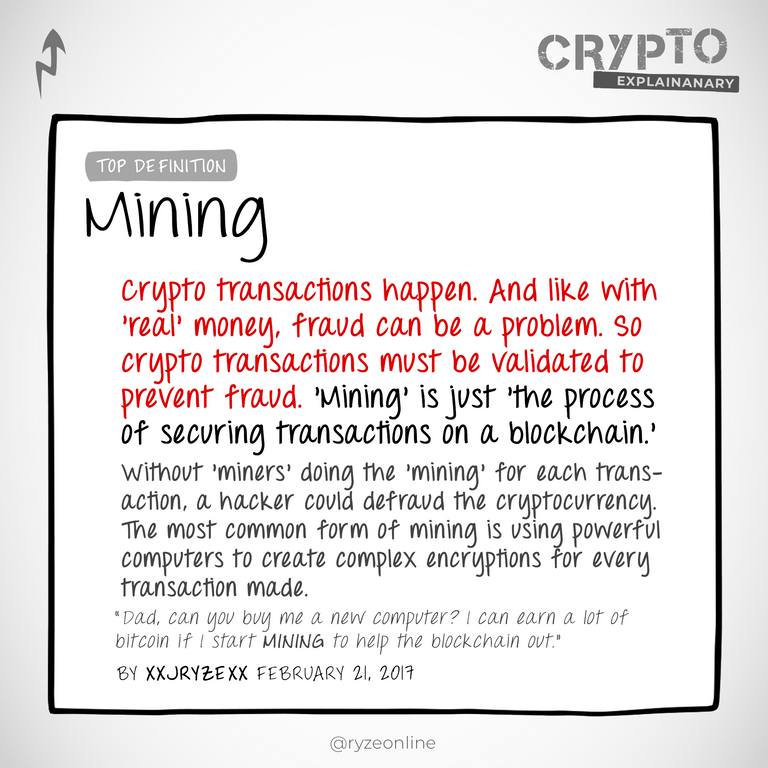
Mining Rig ⭐
| Definition | Example |
|---|
| Mining rigs are computers specially designed to maintain the blockchain network. (See Also: Mining.) | “Dad, when I said I want a new computer I didn’t mean this ghetto laptop, I want a real MINING RIG please.” |
Minnow / Fish ⭐
| Definition | Example |
|---|
| A minnow is someone who owns few digital assets. So, when a minnow buys or sells their crypto, it’s unlikely to significantly impact the rest of the market. | “I finally joined the blockchain but I kind of wish I wasn’t just a MINNOW.” |
Moon / Mooning ⭐⭐⭐
| Definition | Example |
|---|
| When a stock ‘moons,’ or is ‘mooning,’ that stock is having an explosive increase in value. (Not to be confused with ‘moons’, Reddit’s cryptocurrency.) | “I invested in HIVE and to me, it’s already started mooning!” |
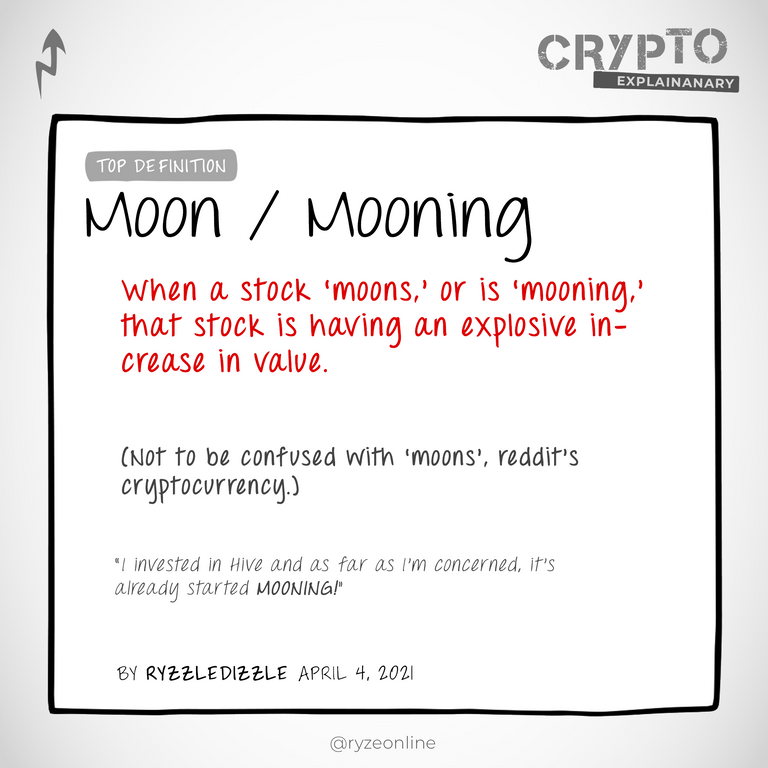
N
NFTs (Non-Fungible Tokens) ⭐⭐⭐
| Definition | Example |
|---|
| NFTs are essentially ‘digital items you can truly own.’ Bitcoins are fungible tokens because they’re not one of a kind. They’re interchangeable. One bitcoin is as good as another. But the Mona Lisa is non-fungible because even an exact copy of the Mona Lisa wouldn’t be as good as the real thing. But what if a digital artist wanted to sell their digital art, the same way a Da Vinci might sell the Mona Lisa? In the past, it’s been difficult to ‘own’ a digital image, because copies of it could be made and shared everywhere. NFTs change this by ‘digitally signing’ each digital item (like a piece of digital art, for example) with a ‘counterfeit-proof’ signature so that the ‘signed’ digital item becomes a ‘one of a kind’ NFT. It can be bought, sold, and verified as the original ‘real thing’, not a copy. | “Eminem created a ‘beat’ in mp3 form, then he turned it into an NFT so it’s now a one-of-a-kind digital item. Then he auctioned it off to a buyer for 100k all from the comfort of his home.” |
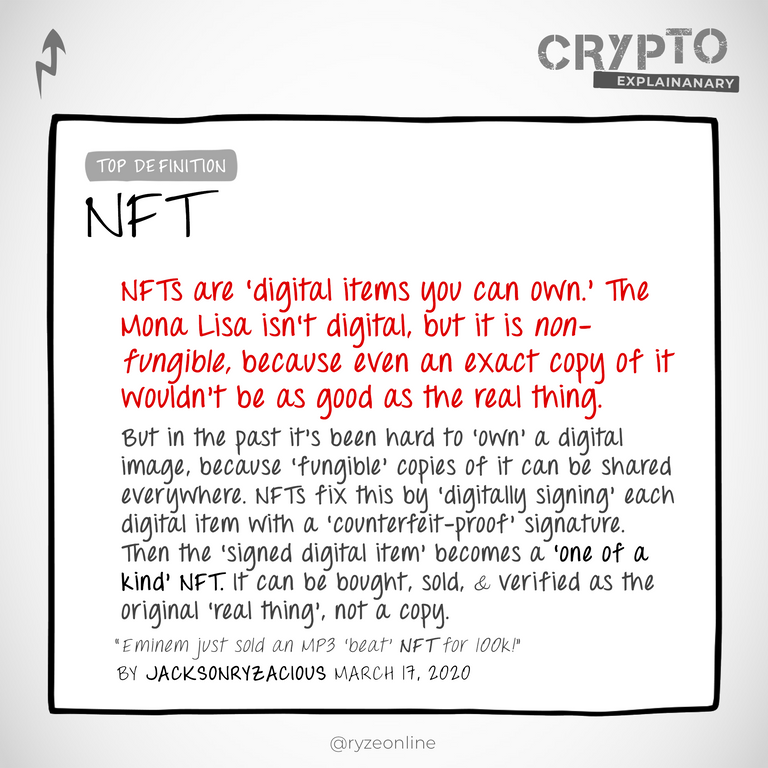
Nifty Gateway ⭐
| Definition | Example |
|---|
| The premier marketplace for buying/selling NFTs. (See also: NFT.) | “I wondered where to sell my NFTs for weeks until someone showed my NIFTY GATEWAY.” |
Node ⭐
| Definition | Example |
|---|
| A node on a blockchain is a ‘program’ that performs a function on that blockchain. For example, a node might validate data, mask/hide IP addresses, create blocks, etc. Usually, these programs are run on dedicated computers provided by the ‘node-owner,’ because these programs work best when run 24/7 to keep the blockchain operating smoothly. Nodes (or the node-owners) are usually rewarded in cryptocurrency for this valuable service. | “I went from sending crypto on the blockchain to helping maintain it when I started my own NODE.” |
No-Coiner ⭐
| Definition | Example |
|---|
| No-Coiners are people with 'no coins,' in other words, they hold no cryptocurrency assets. Usually though, to really be classified as a No-Coiner, one must also believe that the cryptocurrency market will drop in value, so coin-holders will lose money. | “I try to convince my family to get into crypto but they’re all diehard NO-COINERS.” |
O
On / Off-Chain ⭐⭐
| Definition | Example |
|---|
| An 'on-chain' transaction is recorded once it's been validated by a suitable number of blockchain participants (nodes). In contrast, an off-chain transaction takes the value outside of the blockchain network. For example, two people transferring funds to each other through a 3rd party outside of the blockchain. Or say, two people with crypto accounts decide to swap their private keys, in person. This way, the coins never leave the address/wallet, but the currency has gained a different owner, and it all took place 'off-chain.' All sorts of data can be stored off-chain, just as all kinds of data can be stored 'on-chain.' | “Uh, chatting on Facebook is great and all, but I’d really prefer we take this discussion ON-CHAIN.” |
P
Pair ⭐
| Definition | Example |
|---|
| See Crypto Pair. | “...” |
Paper Wallet ⭐
| Definition | Example |
|---|
| A paper wallet works by having a single private key and crypto address / public key (usually generated by a website) printed or written on to paper. | “When I first got into crypto, I didn’t know anything and just relied on a PAPER WALLET.” |
Peer-To-Peer ⭐
| Definition | Example |
|---|
| Peer-To-Peer (P2P) is a decentralized service allowing two individuals to interact directly with each other, without interference by third parties. Instead of storing your data on Facebook's servers, and trusting them to make sure it reaches your audience, instead, your data goes directly from peer, to peer, to peer. There exists Peer-To-Peer file-sharing services, transaction services, storage services, and more. | “I’m tired of relying on corporations and middle-men for all my transactions, it’s way better going PEER-TO-PEER.” |
Help: I appreciate anyone kindly clarifying this definition for readers and myself.
Permission / Permissionless ⭐
| Definition | Example |
|---|
| A 'permissioned' blockchain is one where not everyone has 'permission' to write to the blockchain. Most crypto-enthusiasts frown on this, believing the whole point of crypto is to be 'for everyone', ie: permissionless. | “The beauty of most activities on crypto is that they’re PERMISSIONLESS and everyone can engage in them.” |
Peg / Pegged ⭐⭐
| Definition | Example |
|---|
| A pegged cryptocurrency is one whose value is tied to (or 'backed by') another currency such as gold or U.S. Dollars. First, an exchange rate is established between the two currencies (usually 1:1). Then the cryptocurrency's value changes in sync with the currency to which it is pegged. Unpegged cryptocurrencies are usually volatile, with giant price swings, so some cryptos choose to be 'pegged' to a more stable asset, preventing over-large swings in value. | “Similar to a currency board, Tether is sold at $1.001 and bought at $0.999 in order to keep it PEGGED to the U.S. Dollar.” |
PoA (Proof Of Authority) ⭐
| Definition | Example |
|---|
| Proof of Authority (PoA) is a reputation-based consensus algorithm. In this model, block-validators aren't doing math work (like in proof of work), nor staking coins (like in proof of stake.) Instead, they're staking their own 'reputation.' Transactions are verified by pre-approved participants, acting as moderators of the system. PoA enables companies to get the benefits of blockchain while maintaining privacy. | “PROOF OF AUTHORITY makes participants go through an application and approval process, and their reputations are on the line for every block validated.” |
PoB (Proof Of Burn) ⭐
| Definition | Example |
|---|
| Proof-of-burn (PoB) is a blockchain consensus mechanism with less energy consumption, compared to proof-of-work (PoW). Ensures miners reach consensus by burning coins. Basically, PoB-powered blockchains use ‘coin burning’ in their transaction validation. (Not to be confused with Proof Of Brain, which isn’t really a blockchain consensus mechanism.) | “PROOF OF BURN involves sending crypto to an address that can't possibly have a private key associated with it, for example: ZbXAddressBurnsAllCoinsSentf59kuE!” |
PoS (Proof Of Stake) ⭐⭐⭐
| Definition | Example |
|---|
| PoS lets people pledge their currency for the chance to confirm transaction blocks on the blockchain. How this may look on a blockchain: Coin-holders directly stake their cryptocurrency as individual 'validators' of transactions on that chain. Unlike 'delegated proof of stake', there's no real 'delegating' to another party. Instead, PoS requires running one's own node in the network, then using one's stake as a bond to secure the network. In return for this work, each 'validator' receives a percentage of the coins they have staked as a reward. (Note: Some chains enforce penalties on that stake if validators slack off.) | “Since Ethereum’s blockchain is moving to PROOF OF STAKE, I think I’m going to invest a lot more in it and become an Eth miner.” |
Help: I appreciate anyone kindly clarifying this definition for readers and myself.
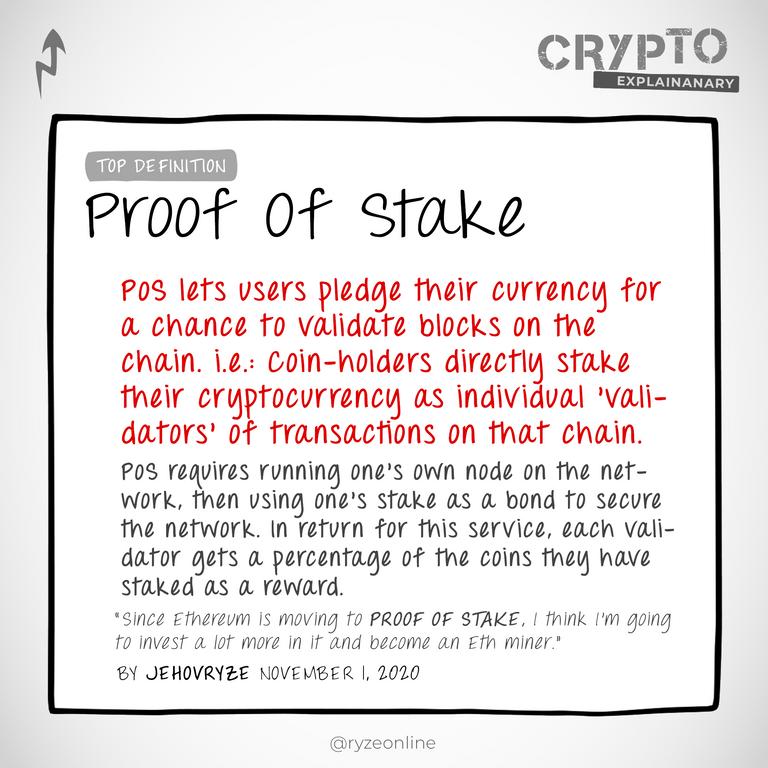
PoW (Proof Of Work) ⭐⭐⭐
| Definition | Example |
|---|
| ‘Proof Of Work’ is one method of securing transactions on a blockchain. Proof Of Work is most famously used by Bitcoin. With PoW, blockchain transactions are stored in blocks. Each block is 'signed' with a really hard-to-calculate number. Which means, every block takes an expensive amount of computing power to record. So if a 'bad actor' wants to maliciously alter transactions, they'll be foiled as soon as the next block in the chain is signed by someone else who did not include the altered transactions. A bad actor can only succeed if they control more computing power than everyone else on the chain combined. (The downside of PoW is that the 'work' of calculating complex equations for every block... is basically wasted electricity.) | “Bitcoin made solving math problems and PROOF OF WORK validation popular.” |
Pre-Mine ⭐⭐
| Definition | Example |
|---|
| 'Pre-mined' means some or all of the crypto coins have already been mined (and distributed) to investors before the official launch date of the coin. This means, no new coins will be created during the mining process. | “As a miner I thought that'd I'd be rewarded with brand new coins during my mining, but I didn't realize the entire supply of coins had already been PRE-MINED.” |
Protocol ⭐
| Definition | Example |
|---|
| Protocols are rules that govern digital platforms. Just as the 'HTTP' Protocol enforces the rules of the world wide web, the 'Bitcoin' Protocol enforces the rules of the Bitcoin blockchain. | “Man, all these new blockchain PROTOCOLS are taking the web forward.” |
Public Address ⭐⭐
| Definition | Example |
|---|
| An 'address' or 'public address' is an encrypted version of the 'public key' from a private/public key-pair. An address operates similar to an email address that funds can be sent to. A crypto 'wallet' will typically run 'encryption' on a public key a few times to create multiple 'addresses' for crypto transactions. Both addresses and the public keys they're created from simply look like a giant string of letters and numbers. The fact that the have similar names '(public address' & 'public key') and that they look similar, can often cause confusion for crypto-newbies. | “I used my private key to create a public key, and from there I generated a PUBLIC ADDRESS that people can send crypto to. Feels great!” |
Private Key ⭐⭐⭐
| Definition | Example |
|---|
| A private key is basically a password. It's a secret string of letters and numbers used to authorize transactions to and from your 'public key' (address). It is very important because your private key literally controls instant access to all cryptocurrency flowing to & from your public key (address). | “Emma, I don’t care how close you and your boyfriend are, never give your PRIVATE KEY out to anyone, do you hear me?” |
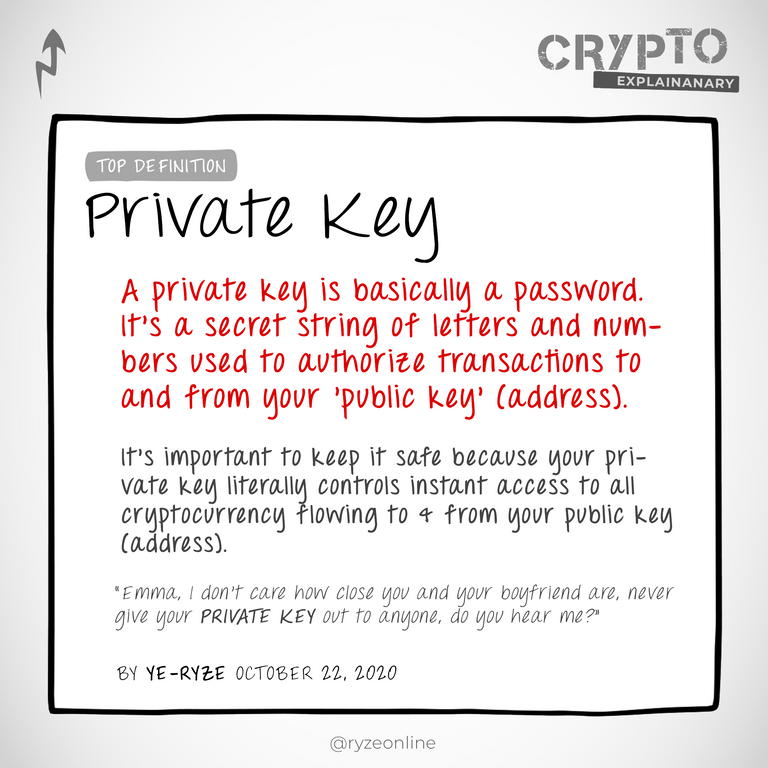
Public Key ⭐⭐⭐
| Definition | Example |
|---|
| A public key is basically an 'address.' (Technically it’s an ‘encrypted version’ of an address.) It's a long string of letters & numbers that operates kind of like an email address does, or like a bank-account number does, but for blockchain transactions. Cryptocurrency is often sent to and from various public keys (addresses). | “Emma, enter your private key to get access to the other half of your key pair, your PUBLIC KEY. From there you can also generate deposit addresses and I’ll make sure you get paid in bitcoin or ethereum.” |
Pump-And-Dump (PND) ⭐⭐
| Definition | Example |
|---|
| Basically a shareholder hypes up a stock to artificially increase demand & raise prices (pump). Then shortly after, he sells all his shares for a huge profit (dump). | “Buy a stock/asset for cheap. Then convince others that it's value will skyrocket. Then Watch the frenzy of believers raise the price of the stock/asset. Now that all the people who've been swindled have raise the price much higher than you originally bought... you sell and make huge returns on your initial investment. Voila, a successful PUMP-AND-DUMP.” |
R
Rug Pull ⭐⭐
| Definition | Example |
|---|
| To pull the rug out from under someone means to to suddenly take away important support from them. In crypto, a rug pull is a malicious tactic where crypto developers run away with investors' funds. This is usually done by removing liquidity from an Exchange or Liquidity Pool. This results in a 'sell' spiral as traders fear they may be left with 'illiquid' assets which aren't tradeable anywhere and end up worthless. | “Looks like Elon Musk just experienced his first RUG PULL in the crypto world, funny how life goes, eh?” |
S
Satoshi Nakamoto ⭐⭐
| Definition | Example |
|---|
| Satoshi Nakamoto is the anonymous name used by the creators of the Bitcoin cryptocurrency. | “Some people think SATOSHI NAKAMOTO is one man, others think it’s a group of developers, some wonder if he/they are even alive.” |
Sats ⭐
| Definition | Example |
|---|
| Like pennies are ‘portions of a dollar’, ‘sats’ are ‘portions of a bitcoin.’ | “I wanted to pay him at least one bitcoin for his work, but I could only afford a few thousands SATS instead.” |
Scamcoin ⭐
| Definition | Example |
|---|
| A scamcoin is a subcategory of shitcoin. It's a fake cryptocurrency created to make money for the creator while stealing money from people who supported and invested in the coin. | “Ugh, Tether is blowing up, everyone’s investing in it, but I bet it’s just a SCAMCOIN.” |
Scalability ⭐⭐
| Definition | Example |
|---|
| Scalability is a trait of something that describes its ability to perform during growth. Something that 'scales well' maintains or increases its performance-level as it's challenged with increased use/demands. | “Bitcoin is the original and most popular, sure, but it doesn’t have anywhere near the SCALABILITY of a coin like Hive.” |

Seed Phrase / Mnemonic Phrase ⭐⭐
| Definition | Example |
|---|
| A list of words which store all the information needed to recover crypto data & funds 'on-chain.' Wallet software generates a seed phrase for the user. If the user's computer breaks, they can download the same wallet software elsewhere, then use their seed phrase to recover their cryptocurrency. | “As long as you keep your SEED PHRASE safe, you can access your keys & crypto from practically any device, anywhere.” |
Shill ⭐
| Definition | Example |
|---|
| 'Shill' (or 'Shiller') encourages others to invest in a cryptocurrency, usually less-than-tastefully. A NudeCoin shill encourages people to invest in NudeCoin. A Tether shill encourages people to invest in Tether. They do this so that hype grows, people buy the coin/token, and the price of it increases. | “I’m so tired of these SHILLS popping into our forums and shilling their lame projects and coins.” |
Shitcoin ⭐
| Definition | Example |
|---|
| Shitcoin started as a term to describe digital coins other than Bitcoin, but has evolved to mean any coin that is shady and/or has little monetary value or future potential. (See Also: Altcoin.) | “Wait, are you serious? There’s a coin called ‘Feed Every Gorilla?’ Man, this sounds like a SHITCOIN.” |
Sidechain ⭐⭐
| Definition | Example |
|---|
| Sidechains are programs that allow tokens/assets from one blockchain to be used in a separate blockchain, then be moved back to the original blockchain (if needed.) Sidechains have potential to greatly enhance existing blockchains. | “Want to test your new, potentially unstable code without ruining our blockchain? I highly suggest deploying it on a SIDECHAIN first.” |
Slippage ⭐
| Definition | Example |
|---|
| Slippage is a difference in what you think you’re paying to acquire crypto, and the actual cost you pay. This can happen with highly volatile, high-demand assets like cryptocurrency, because there may not be enough shares to accommodate buy or sell orders, and a ‘next-best’ price must be used. Savvy traders are often able to use slippage for their own profit. | “With all these people buying and selling Bitcoin, I’m pretty sure I can profit well on the SLIPPAGE in large orders.” |
Help: I appreciate anyone kindly clarifying this definition for readers and myself.
Soft Fork ⭐
| Definition | Example |
|---|
| A soft fork is changing blockchain software in a way that modifies node behavior but doesn't break any consensus rules of older clients. | “Don’t worry, it’s going to be an easy update that won’t affect you very much, it’s just a SOFT FORK.” |
Speculation ⭐⭐
| Definition | Example |
|---|
| Speculation is the buying and selling of goods in the hopes that they increase in value between the time you buy and the time you sell. (Often this means the speculator doesn’t care about the product, service, brand, or asset they’re trading.) | “I don’t actually care about crypto to be honest, I just SPECULATE on price swings, then take my profits as fiat.” |
Smart Contract ⭐⭐
| Definition | Example |
|---|
| Any purchase or transaction is a contract. For example: "I'll give you bitcoin in exchange for some coffee." A smart contract is a contract with programming or 'code' attached. For example, the coffeeshop could add code that gives purchasers one free cookie for every ten coffees purchased from the same address. Or more complex code could be attached to a smart contract that lets you automatically pass on inheritance to your children. Or one that allowed customers to bet on outcomes and be automatically awarded prizes. Endless possibilities, all automatic, with no middle-man. | “This is so cool! I just used a SMART CONTRACT to create an ‘escrow’ that releases funds only when someone passes my security checks!” |
Stake / Staking ⭐⭐⭐
| Definition | Example |
|---|
| Blockchain transactions must be verified to avoid fraud. So chains incentivize people to 'verify' each 'block' of data. Bitcoin does so with 'Proof Of Work', but that system had some problems, so some newer coins incentivize miners with a Proof Of Stake system instead. In this system, to 'stake' is to 'delegate' your coins/tokens back to the network, as a reward to miners for minting & verifying new blocks on the chain. On most chains, your coins are not lost, they’re simply ‘locked up’ for the duration of your stake, and easily reclaimed. Staking in this way usually earns the staker interest, so the miners win, the chain wins, and the staker wins. Basically, staking is each individual's way of helping to secure the network, and can be treated kind of like a mid-interest savings account. (See Also: Proof Of Stake, Delegation.) | “At first I was just using the blockchain, but now I’m really STAKING hard and the benefits are pretty big.” |
Help: I appreciate anyone kindly clarifying this definition for readers and myself.
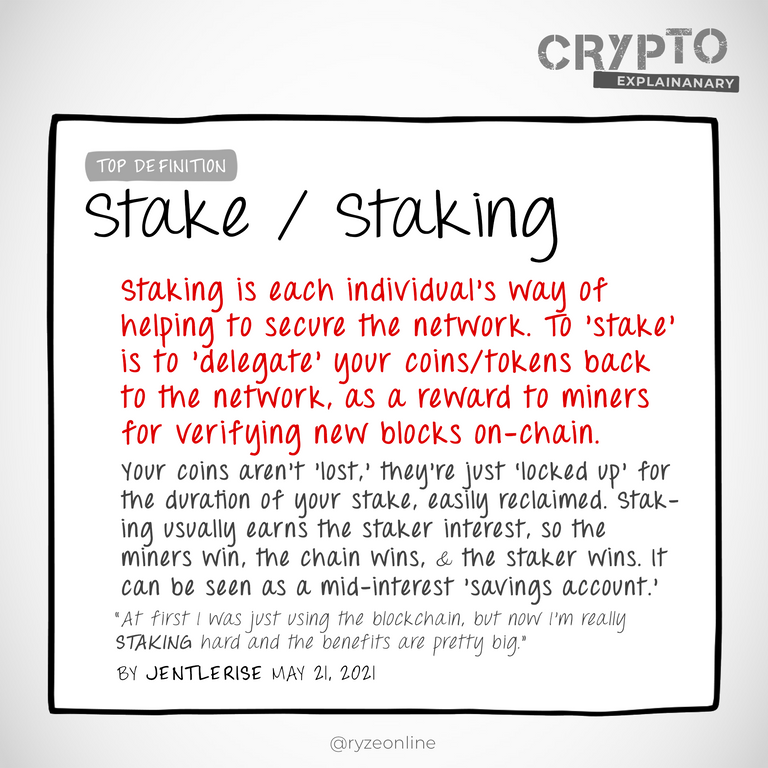
Stablecoin ⭐⭐
| Definition | Example |
|---|
| A 'stablecoin' is a cryptocurrency whose value is tied to an outside asset like the U.S. dollar or gold to stabilize the price, unlike most cryptocurrencies with extremely volatile valuations. | “STABLECOINS aren’t that useful to me right now, but I do use them like a ‘savings’ to hold my crypto in, since they tend to earn safe, reliable interest.” |
Stealth Address ⭐
| Definition | Example |
|---|
| Stealth addresses are used to obscure public access to the parties involved in certain blockchain transactions. | “I know blockchains are transparent and all transactions can be looked up, but at least I used a STEALTH ADDRESS for extra privacy this time.” |
Store Of Value ⭐
| Definition | Example |
|---|
| A store of value is an asset capable of retaining value over time. For a long time, gold was a very popular ‘store of value.’ If you purchased gold as a ‘store of value’ today, you’d be fairly sure its value wouldn’t depreciate over time, and even may expect it to be worth more. In crypto, bitcoin is the most commonly cited ‘store of value’, but this is hotly debated. | “Gold has been a STORE OF VALUE for hundreds of years, but it’s hotly debated whether or not Bitcoin qualifies as the same.” |
T
Technicals ⭐
| Definition | Example |
|---|
| ‘Technicals’ are the short-term price/volume fluctuations. Technical analysis tries to determine which way the price of an asset will move based on information like its price and volume. It puts minimal emphasis on an asset’s intrinsic value, and mostly involves ‘reading chart patterns’ in the short-term. | “Over time, patterns in the financial charts of an asset emerge. Making trading decisions off these patterns is called TECHNICAL analysis.”* |
Throughput ⭐
| Definition | Example |
|---|
| Throughput is the rate that transactions are recorded by a blockchain (in a set time period.) It's measured in transactions per second (tps). Bitcoin? 7 tps. Cardano? 250 tps. Iota? 1500 tps. | “I’m switching to Cardano simply because of their higher THROUGHPUT.” |
Token ⭐⭐⭐
| Definition | Example |
|---|
| In the analog world, a token is a piece of data that stands-in for a more valuable piece of data. For example, poker chips are tokens that represent cumbersome wads of cash. In the crypto world, tokens on a blockchain can represent all sorts of things. In crypto, a coin is similar to a token, but 'tokens' usually don’t have their own blockchain. Instead, they make use of other blockchains, like the Ethereum blockchain. If the Ethereum blockchain ever shut down, many companies’ tokens would shut down along with it. Bitcoin, on the other hand, would continue on, since it’s a coin with its own blockchain, not a token using someone else’s blockchain. In crypto, ‘token’ usually refers to a cryptocurrency or crypto asset of some sort. | “I bought a lot of Ether coins recently, plus I’ve made a bunch of NFTs, and learned to code. At this point, I’m seriously considering using Ethereum’s infrastructure to launch my own TOKEN.” |
Help: I appreciate anyone kindly clarifying this definition for readers and myself.
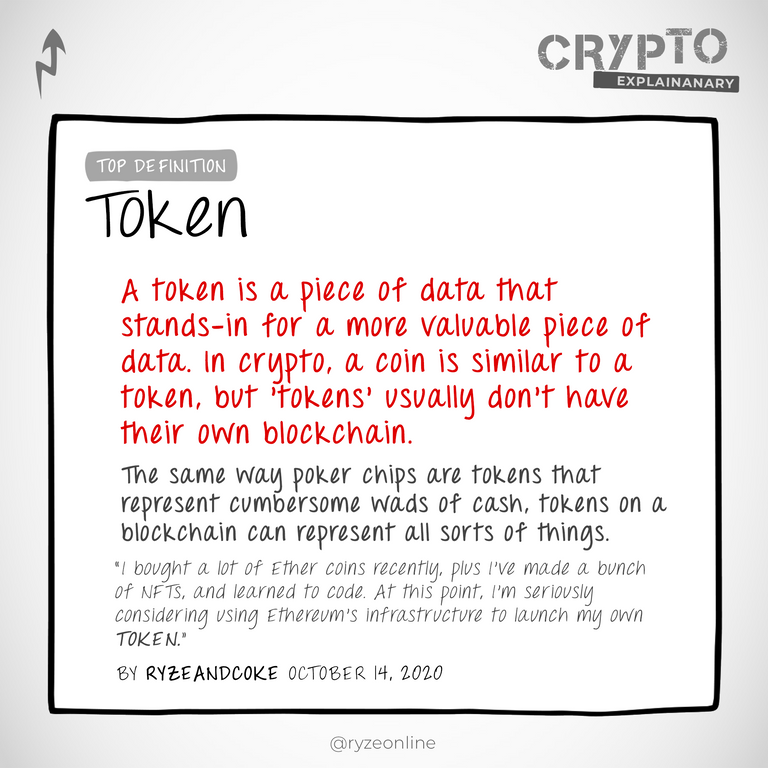
Tokenomics ⭐
| Definition | Example |
|---|
| Tokenomics is sometimes known as 'token economics' or 'crypto-economics.' It's the study of economic policies applying to ‘tokenized’ assets. As more and more assets become tokenized on the blockchain, tokenomics become increasingly important. | “Dude, I love that you’re launching so many blockchain projects, but have you actually looked at the TOKENOMICS of it all?” |
Tokenize ⭐⭐
| Definition | Example |
|---|
| Tokenization (in the crypto world) means creating cryptocurrency ‘tokens’ that represent assets. For example, if Nike were to ‘tokenize’ their brand on a blockchain, the public could then purchase ‘Nike Tokens’, which would in turn give them part-ownership of the Nike brand or some other benefit. | “Is it just me or are people TOKENIZING literally everything these days? I bet Belle Delphine will somehow tokenize her bathwater.” |
Help: I appreciate anyone kindly clarifying this definition for readers and myself.
Trade / Trading ⭐⭐⭐
| Definition | Example |
|---|
| Trade is the transfer of assets from one entity to another (often for money). It began with 'bartering' back in caveman times. The invention of money/credit/crypto has made trade easier, but also more nuanced, since bartering days. Buying, selling, and exchanging are all 'trade' transactions or examples of ‘trading.’ | “I’ve been TRADING all day and I think when the market finally closes I’m going to be rich.” |
Transaction (Tx) ⭐⭐⭐
| Definition | Example |
|---|
| A transaction is when someone sends data (often money) to someone else. Transactions on a blockchain are ‘transparent’, meaning they can be looked up by anyone, but they’re also mostly ‘anonymous’ since no names are involved, only ‘hashes’ and long, encrypted strings. Each blockchain has their own methods of verifying each transaction and preventing ‘double-spending’ (counterfeiting.) | “I found an NFT I liked, sent the crypto to the artist, and am now the proud owner of an Eminem beat. Ta-da! TRANSACTION complete.” |
Trustlessness ⭐
| Definition | Example |
|---|
| Trustless arises from a sufficiently decentralized cryptocurrency or blockchain. In such a network, trusting a third party to be a 'good actor' is unnecessary, since everything is recorded on a wide network of peers, and no one person's agenda can swoop in and censor things. The network works the same for everyone, is difficult to censor, and requires no 'trust' in the developers once it's running correctly. | “Nothing is one-hundred percent TRUSTLESS, but the chains I’m on are so decentralized they might as well be.” |
U
Utility Token ⭐
| Definition | Example |
|---|
| A utility token is a blockchain asset people buy with the intention to use in the future. For example, an online game company could issue 'utility tokens' to fund the development of the game. Once their game’s development has finished, the token-owners could then use the tokens for in-game purchases. The tokens have a use. This is just one example, utility tokens are versatile with a wide range of uses. It's worth noting that utility tokens do have value, but can't be considered money as straightforwardly as a crypto 'coin' might. | “While Bitcoin is a 'digital currency', the Basic Attention Token (BAT) is a UTILITY TOKEN that can be exchanged for various services on the Brave Browser, as well as for select premium content.” |
UTXO (Unspent Transaction Output) ⭐
| Definition | Example |
|---|
| A UTXO is basically cryptocurrency that is currently ‘locked up’ on the blockchain. It is ‘unspent.’ When a transaction occurs on the blockchain some transactions have ‘unspent outputs’, until those outputs are used in a future transaction. If a woman tries to spend a twenty-dollar bill in a shop, she gives up the entire note, receives the goods, and takes back her remaining change. UTXOs operate similarly on the blockchain. | “Emma, UTXOs are kind of like a technical term for tokens, because each transaction, (whether sent or received), involves 'spending' UTXOs-- and if they're not fully spent, there will be some 'change' leftover from the transaction, just like there would be when using fiat cash.” |
V
Validation ⭐
| Definition | Example |
|---|
| When a transaction is made, it gets relayed across all nodes in the network. Miners get notified and verify the transactions (through complex crypto math), adding them to a block. At that point, other nodes in the network confirm that the hash is correct until the majority of nodes are in 'consensus.' (Note: Validation requires block-validators verifying the authenticity of transactions, while consensus requires agreeing on the ordering of events in a blockchain. Therefore validation comes before consensus.) | “The hackers double-spend counterfeit attempts failed because their transactions didn’t pass the miner’s VALIDATION.” |
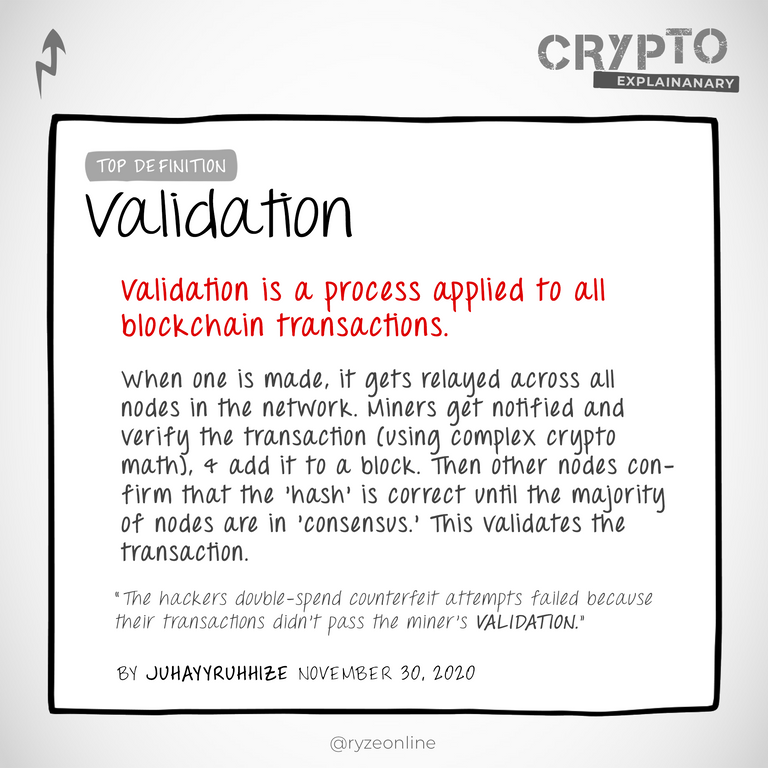
Validator ⭐
| Definition | Example |
|---|
| Validators are ‘node’ operators who each store a copy of the blockchain and must perform certain functions to keep the system secure. | “When deciding what kind of node I wanted to be, ultimately I went with VALIDATOR.” |
Vitalik Buterin ⭐⭐
| Definition | Example |
|---|
| Vitalik Buterin is the outspoken Russian-Canadian programmer who created Ethereum. | “I'd love to have a beer with VITALIK BUTERIN, and talk about his unique views on where blockchain is taking the world.” |
Volatility ⭐
| Definition | Example |
|---|
| Volatility is the range of value an asset experiences over a given period of time. If the price is mostly stable, the asset has low volatility, while a highly volatile asset hits new highs & lows quickly and has fast increases and dramatic drops. | “I’m going to stick to investing in traditional stocks, the crypto world has way too much VOLATILITY right now.” |
W
Wallets ⭐⭐⭐
| Definition | Example |
|---|
| A 'wallet' in the crypto world is any place where your private key ('long password') can be stored and connected to your public key ('encrypted address'). Even a piece of paper can accomplish this, if the need arises. A crypto wallet, at its core, is an 'address.' But it can also contain the public & private key for many of your other crypto addresses. (Note: Some people assume that a 'wallet address' and the 'public key' are the same. They're not. Instead, they're separate things, but mathematically related/connected. A 'wallet address' is a 'hashed version' of your public key.) A (crypto) wallet is less like a leather billfold that stores money, and more like a keychain that stores keys. | “I think it’s time for me to ditch my online WALLET and switch to a ‘cold’ wallet like Trezor for more security.” |
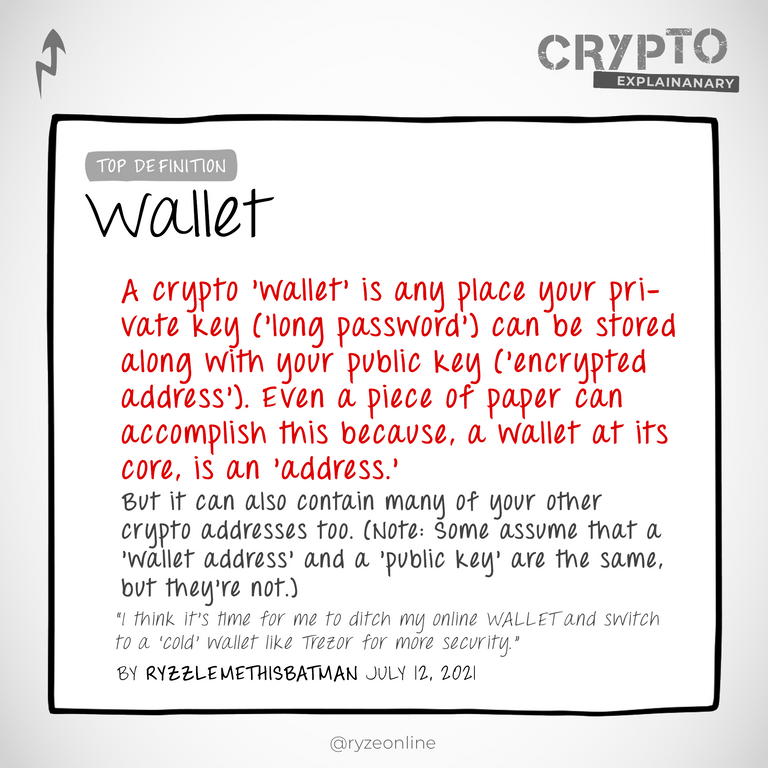
Weak / Paper Hands ⭐⭐
| Definition | Example |
|---|
| Paper Hands / Weak Hands is when traders sell their assets 'too early' before they're able to reach significant profits. | “I’m fed up with people joining the chain and then pulling out of it almost immediately. These chumps have such PAPER HANDS.” |
Web 2.0 ⭐
| Definition | Example |
|---|
| Web 2.0 is 'the web as a platform.' Apps are built on 'the web' allowing users to participate in content creation and social networks, disrupting traditional media, advertising, and retail industries. Web 2.0’s business model relies on user participation to create fresh content and profile data to be sold to third parties for marketing purposes. This eventually led web 2.0 to being the foundation of 'Big Tech.' | “Google, Facebook, YouTube and all of WEB 2.0 is on its way out in my opinion.” |
Web 3.0 ⭐⭐
| Definition | Example |
|---|
| Blockchain tech allows for data decentralization and a transparent, secure environment. These are the foundations of web 3.0, and they're poised to overtake Web 2.0’s centralization, surveillance, and exploitative advertising. Web 3.0 is aimed to let individuals own and be properly compensated for their time and data. | “Pretty soon everything is going to be done on-chain, WEB 3.0 is the future, believe you me.” |
Whale ⭐⭐
| Definition | Example |
|---|
| A whale is someone who owns a lot of cryptocurrency and/or a lot of influence on one or more blockchains. | “When I started I was a minnow, but now I’ve amassed so much crypto, even a single trade of mine can upset the market. Ah, it feels good to be a WHALE.” |
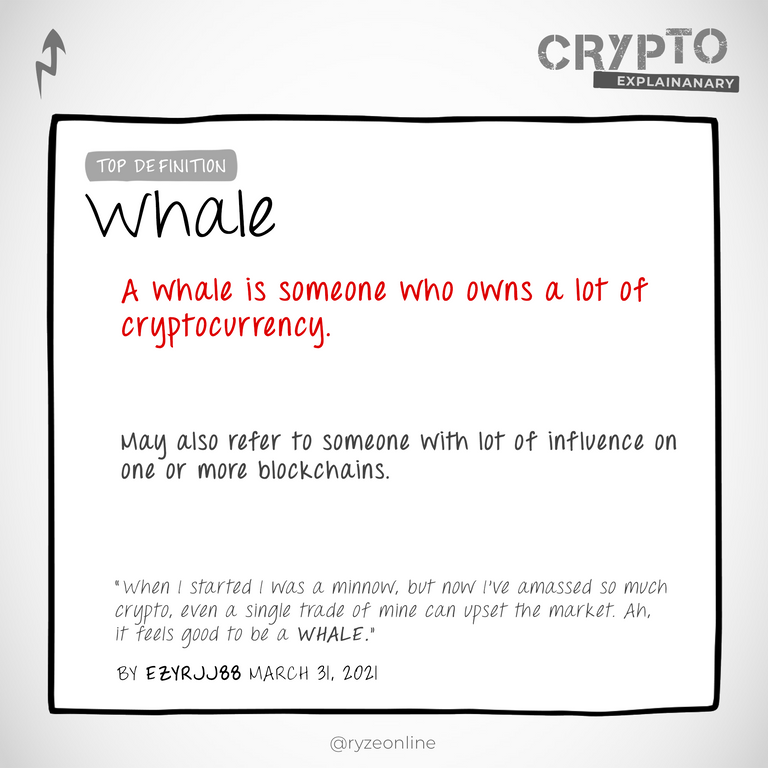
Whitepaper ⭐⭐
| Definition | Example |
|---|
| A white paper is a document which outlines a problem, the solution to that problem, and the details of how a product/service interacts with it's users. | “Z” |
Witness ⭐⭐
| Definition | Example |
|---|
| There is ‘witness’ data which are bits of code attached to every transaction on the Bitcoin blockchain. There’s also ‘Segregated’ Witness, which is witness data that has been separated from transactions on the blockchain. Finally there are ‘Witnesses’ on the Hive Blockchain (or Steem) Blockchains, which are actual ‘people’ running ‘witness’ nodes. (Unsurprisingly, like much of crypto, terminology here is ambiguous and confusing. I wish I could explain this better but was unable to find clearer answers.) | “A WITNESS node? Or Segregated witness? Or Witness data? These terms make my head spin and I honestly have no idea what this one means.” |
Help: I appreciate anyone kindly clarifying this definition for readers and myself.
Y
Yield Farming ⭐
| Definition | Example |
|---|
| Yield farming is any effort to put crypto assets ‘to work’ and generate the most returns possible on those assets. For example, a ‘yield farmer’ might move assets around, constantly chasing whichever pool is offering the best APY (Annual Percentage Yield). | “I’m basically yield farming at this point, I don’t commit to holding assets really, I just invest in whatever pool earns me the most, period.” |
HIVE SPECIFIC TERMS
3Speak ⭐
| Definition | Example |
|---|
| 3Speak is a dApp that’s basically a blockchain-based version of YouTube. If you want to post videos directly on the Hive blockchain, 3Speak is the main dApp to do so. | “YouTube will just ban me again, I’m loyal to 3Speak now.” |
Beneficiaries ⭐
| Definition | Example |
|---|
| When you write a post on the Hive blockchain, there’s ‘advanced’ options at the bottom of the post editor for ‘post payout.’ One of these is to add ‘beneficiaries.’ They're people you've decided shall receive a percentage of your post payout. It’s like sharing earnings with friends or collaborators. (i.e: beneficiaries.) | “They all helped edit, proof-read, and illustrate my post, so I set them up as BENEFICIARIES.” |
Communities ⭐
| Definition | Example |
|---|
| ‘Communities’ on Hive are kind of like subreddits on reddit, or ‘Groups’ on Facebook. | “I know I’m new to Hive, and I should probably take it slow, but I really want to start an ‘Unpopular Opinions’ COMMUNITY.” |
Curation ⭐⭐
| Definition | Example |
|---|
| Authoring content on Hive involves posting a publication. Curation is managing the visibility of such content. Upvoting is a form of curation, since it boosts an author's content. Creating a 'curation post' where you feature a group of posts by authors could be seen as another form of creation. Downvoting mean comments would be yet another example of curation. Curation is done habitually by most content-consumers and ‘lurkers.’ | “I admit I don’t post much, but I do a lot of CURATION and content-consuming.” |
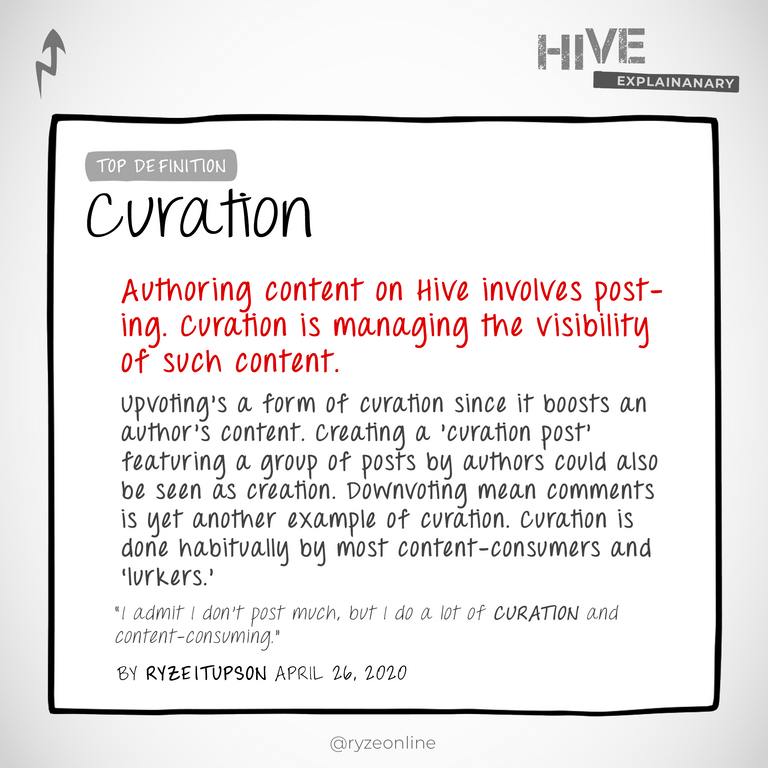
Curation / Vote Trail ⭐⭐
| Definition | Example |
|---|
| A curation trail is actually more like a ‘curation pyramid.’ Some Hiver at the top of the pyramid is voting, let’s say. And a bunch of other Hivers want to use their voting power to increase earnings, so they give some of their ‘votes’ to the guy at the top of the pyramid. Why? Could be any reason. They’re too lazy to vote. They trust the top guy to find better content than them. They want more efficient, ‘automated’ voting. Etc. Now, they can sit back and relax and let someone else do their voting and curation, while their account reaps the rewards in crypto. This behavior is sometimes celebrated, and sometimes frowned upon. | “It might seem lazy to you, but I’m just too busy to use up my daily votes, so I joined a CURATION TRAIL.” |
DHF (Decentralized Hive Fund) ⭐
| Definition | Example |
|---|
| The ‘DHF’ (currently @hive.fund) allows Hivers to publicly propose work they’re willing to do in exchange for pay. Once a proposal is made, Hivers vote on the proposals, and assuming the proposal passes, it gets funded by the DHF. | “A percent of all proceeds to my project gets sent back to the DHF, benefitting all of Hive.” |
HBD / Hive-Backed Dollars ⭐⭐
| Definition | Example |
|---|
| Hive-Backed Dollars (HBD) are ‘bundles’ of HIVE tokens that are equal to 1 US Dollar. They’re meant to be a stablecoin, pegged to USD. | “I find it easier to deal in HIVE-BACKED DOLLARS rather than Hive, just because it’s so conveniently pegged to U.S. currency.” |
Hive Power / HP ⭐⭐⭐
| Definition | Example |
|---|
| Hive Power is basically clout, or influence. The more Hive Power you have, the more influence you have on the Hive platform. Your votes & comments ‘mean more’ and your shares ‘reach more.’ Your resource credits (gas) is proportional to your HP. (Hive Power is essentially illiquid.) | “Every post I make has been increasing my Hive Power, but I’m considering powering-up even more to increase my influence and become a whale.” |
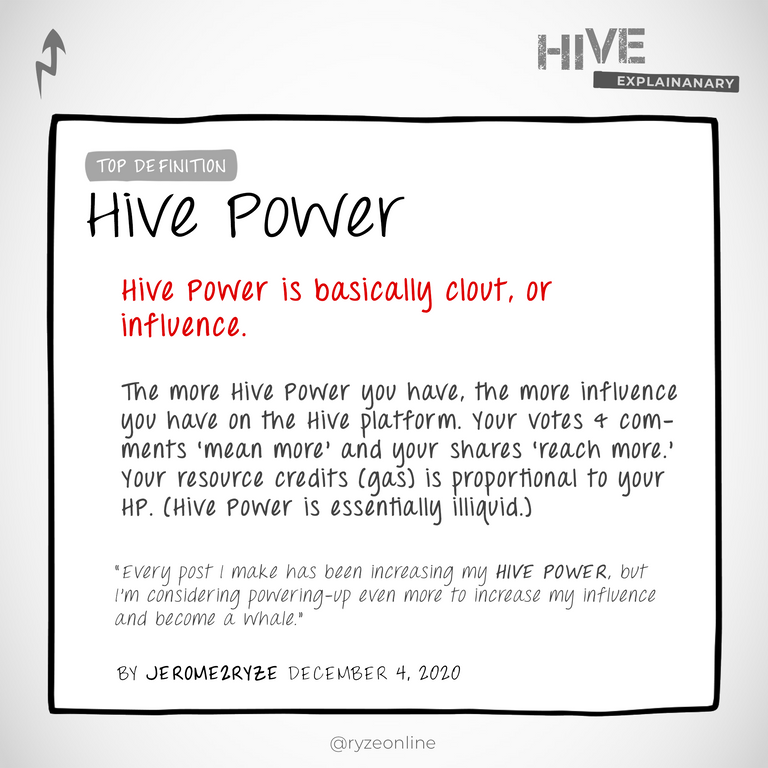
Hive Tokens ⭐⭐⭐
| Definition | Example |
|---|
| HIVE Tokens (HIVE) is the primary currency on the Hive blockchain. It’s similar to bitcoin. (ie: HIVE is the main token on the Hive.io blockchain, just as Bitcoin is the main token on the Bitcoin blockchain.) You can spend, receive, transfer, and trade HIVE. (Also sometimes called ‘Hive Tokens,’ or ‘Hive Coins.’)” | “HIVE TOKENS are the main cryptocurrency on the Hive blockchain, and they’ve been rising in price lately.” |
Keychain / Hive Keychain ⭐
| Definition | Example |
|---|
| A program or plugin that keeps track of your private keys and automatically enters them into any dApp on the Hive Blockchain for you. This saves you the trouble of remembering and typing giant strings of encrypted letters and numbers every time you click ‘post’ or ‘upvote’, as well as letting you perform many other actions on the blockchain. | “Once I got my KEYCHAIN set up, it became really easy to use all the dApps on the Hive blockchain.” |
Proposal ⭐⭐
| Definition | Example |
|---|
| On many blockchains, like Hive, people can propose changes to the blockchain, or blockchain-related work they’re willing to do in exchange for pay, such as marketing efforts or the creation of helpful dApps. These proposals may then be either implemented or rejected, usually through proposal-voting by members. | “Dude, you have so many good ideas on how to market Hive, why don’t you make a PROPOSAL?” |
Resource Credits ⭐⭐⭐
| Definition | Example |
|---|
| Resource credits are basically the ‘gas’ tokens to pay ‘gas fees’ on Hive. A new user starts on Hive with very few resource credits, so after even a single vote or comment they may run out and find themselves in ‘RC Jail.’ (Where a Hiver ends up when resource credits reach 0.) That said, even veterans can end up there through an RC Blowout -- rapid consumption of resource credits to the point where RC Jail becomes a real possibility. (See Also: Gas.) | “When I first joined, I kept getting errors when I posted or commented.. It took me ages to figure out that I was short on RESOURCE CREDITS.” |
Rewards ⭐⭐⭐
| Definition | Example |
|---|
| Crypto-based social platforms like Hive often ‘reward’ users for their posts and comments in the form of small amounts of cryptocurrency. Often only a percent of a coin, but it can add up quickly because you’re doing so many clicks and getting so many ‘votes’ (‘likes’) on social. Hive pays out rewards usually as a combination of Hive Tokens and Hive-Backed Dollars. | “Hivers get pretty upset if you call it ‘earning money’ or ‘earning crypto’, instead you have to label it as earning REWARDS.” |
Splinterlands ⭐
| Definition | Example |
|---|
| Splinterlands is a crypto-based digital card game. Insanely popular. It’s literally the single most active dApp on Hive. | “I should probably be working, but I decided to play a few hours of SPLINTERLANDS.” |
Voting Mana / Voting Power ⭐
| Definition | Example |
|---|
| ‘Voting Mana’ is like an ‘energy-meter’ in a video-game. You start out with 100% voting mana, but it drops a bit for each vote you make. It also recharges at a rate of about 20% per day. | “I didn’t want my voting mana to sit unused and wasted, so I made sure to do my daily votes.” |
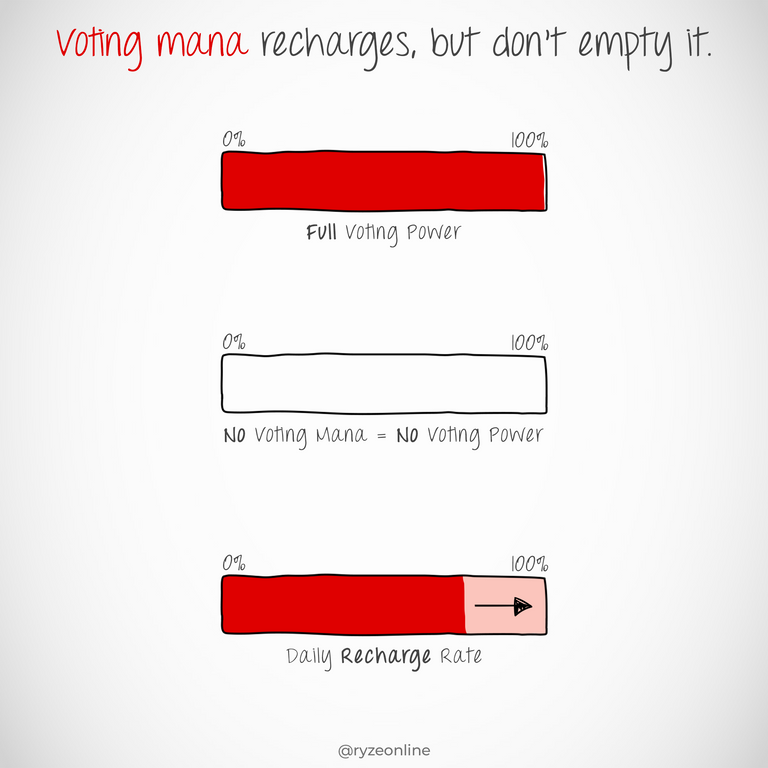
Vote Weight ⭐⭐
| Definition | Example |
|---|
| Vote weight is something you ‘set’ each time you vote. Whatever vote weight you choose decides how much ‘money’ you’ll invest in your vote. People with more Hive Power (Influence) have votes like everyone else, but each vote they make carries ‘more weight.’ Also, as your vote-mana drops, so does your vote-weight, at least until it recharges. If you let your voting mana reach zero, your votes will have zero weight, and become similar to a ‘like’ on Instagram… basically worthless. | “OK, I don’t have a lot of Hive Power and I may have voted too much today, so actually, my vote weight is too low to help you much, sorry.” |
There’s so much more to Hive.
There’s lots to explore that I can’t cover here, which is why I wrote “Hive: A Complete Beginner's Guide (With Fun Doodles).” It has gotten a lot of praise here in the few months since it’s been live, and it holds tremendous value for Hivers, both new and old. I highly encourage you to check it out if you haven’t yet.
Whew.
OK.
So there you have it, all the terms for beginner-to-intermediate crypto fans that I felt would be helpful, plus a brief section for Hive's ‘social’ blockchain. This wraps up a monster project that turned out to be bigger than I expected, but hopefully it was valuable to you. Thanks so much for reading, and if you got value from this post, I’d appreciate any votes, comments, and shares you feel like giving. It means a lot to me. Plus, this kind of glossary could help many people get into the world of crypto & Hive much more easily, so it’s extra helpful if you’re able to spread this ‘off-platform’ (tweet it, Facebook-it, etc.) to anyone who may be want to get their feet wet in the crypto-universe.
Crypto doesn’t have to be intimidating, and understanding the language is vital, imho.
And if you have a ‘simple,’ ‘beginner-friendly’ correction or improvement to make to these definitions...
...please phrase them as kindly as possible in the comments and I’ll aim to update this glossary, because as I said, I’m only three months into the crypto world.
P.S. If you liked what you learned here, and are eager to grow your Hive Success, here’s some other helpful posts you may get a lot of value out of:
Special thanks to my favorite stock site, Envato.com, for help with images.
I’ll tag a handful of people who onboard people to Hive, or who help newcomers… maybe this glossary will save time explaining some terms or something: @acidyo , @offgridlife , @crosheille , @traciyork , @phage93 , @mattclarke , @tobetada , @finguru , @brittandjosie , @wesphilbin , @wil.metcalfe , @ybanezkim26 , I love you all and hope this helps save you time explaining things to people.
















You missed one that is part of the crypto culture. It is "safu". A term that originated when Binance had to stop trading the cryptocurrency Syscoin because it had some crazy moves. One of the support staff told a customer that his funds are "Safu" instead of safe.
The CEO of binance, used that to his advantage and started joking when he saw it was going viral on Twitter. They then created the Secure Asset Fund for Users and the term has been used a lot since then. Look for the full story, you'll love it.
Thanks so much @danielvehe , this is an awesome contribution! Hahaha, typos becoming actual words is pretty funny. And huge props to the Binance CEO for leveraging it into something positive.
Both parts of this post are currently very close to Hive's character limit so I'm not sure if I can add any more terms, so for now I'll add it to the comments for anyone who's curious.
Safu ⭐
Thanks so much again for stopping by, noticing that I missed a key word, and teaching me something new. You have made me feel so SAFU. 🤣🙏
I have been waiting for this! It will come in handy, even for people that aren't new and are still struggling. There are a lot more than I thought.
I reposted one and two and bookmarked them!
Thanks again! You are awesome!
Aw thanks for the kind words, and I'm super-grateful for the shares. I rely on people like you to work your magic and make sure stuff like this gets into the right hands. Thank you too, you rock! 🙏
Thank you so much, you rock! 🙏
Thanks again for posting this glossary. I bookmarked Part 1 and Part 2.
Here's another !PIZZA !!
Posted Using LeoFinance Beta
$PIZZA@ryzeonline! I sent you a slice of on behalf of @magnacarta.
Learn more about $PIZZA Token at hive.pizza (3/10)
🙏
You're awesome, ty! And thanks for this abundance of pizza and air-guitar! 🙏
Thank you!!
It's always fun when we win, and it's always fun when we earn. When we do both, it's EPIC WIN!
Posted Using LeoFinance Beta
Hahaha... couldn't have said it better myself, hear hear! 🙏
again, fantastic!
@tipu curate
Upvoted 👌 (Mana: 31/91) Liquid rewards.
🙏
And again, thank you for helping this reach others! You rock! 🙏
Amazing info, i needed it.
My pleasure, so glad you found value in it! 🙏
Fantastic write up, I learnt a lot . Whew!!! I’m about to read most of your articles now.
Thank you for saying so! And I trust you'll benefit from my other articles, as I aim to pack a lot of value into them. Have a great day! 🙏
Yay! I read both of these today more carefully than I did the other day and I gotta say I never felt dumber LOL just kidding just kidding...kinda 😝 I did learn a bunch so thank You again for this. You did a tremendous job. I'm so glad I have this resource to help people with. You're AH-Mazing ❤️
(grin) lol, I'm so glad you learned a lot from them and appreciate all the love that went into 'em. Much love! 🙏
❤️😘❤️
your posts are always GOLD, I can't stop reading them, to see what you do with the markdown and the graphics you put is really amazing, keep doing this kind of content please.
video on my emotional Hive journey?, you might enjoy. Either way, thanks again! 🙏Thanks so much @burnoutawesome ! I've enjoyed and commented on a few of your gaming posts too, they're great! Comments like this one are really encouraging and makes me want to post more. I appreciate it. Here's a post you may have missed -- Did you see my
What a lovely comment @burnoutawesome and I agree. I love his posts...he puts so much love into each one. I appreciate your words ❤️
Brilliant work, really gives an indepth to crypto, espeically HIVE in general and all associated with voting power etc that new users like myself might not get immediately. Its great :)
Posted Using LeoFinance Beta
Thank you, I know a lot of the terms can be confusing, so I did my best to simplify them for readers. Thanks again for all your kind comments, they really mean a lot to me. 🙏
Thanks @adani , I did my best, so I really appreciate you saying this! 🙏